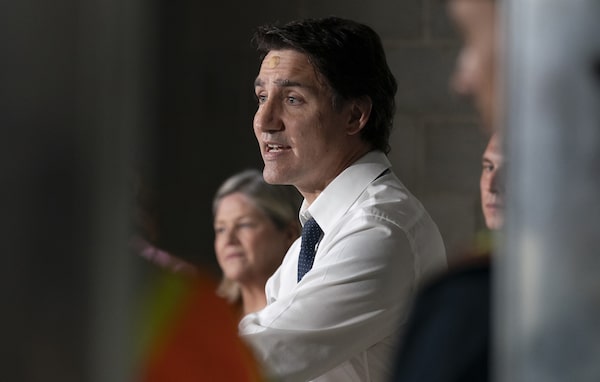
Prime Minister Justin Trudeau speaks during a visit to an apartment complex under construction in Hamilton, Ont., on July 31.Peter Power/The Canadian Press
For two decades, from the mid-1990s to the mid-2010s, through Liberal and Conservative governments, Ottawa was largely absent from housing.
Justin Trudeau’s Liberals in 2015 promised to change that, with major federal investments in affordable rental housing. As of March, Ottawa had committed more than $30-billion (much of it low-cost loans for rental housing), and the result is 107,519 new homes.
It is at once a success and failure. It’s more than Ottawa has done in a long time – and it’s far, far too little. The Trudeau government has been overtaken by events: an out-of-control housing market where the cost to buy or rent is extreme.
The situation has brewed for decades, and the blame can be pinned on city councils whose restrictive zoning laws keep the supply of housing well below demand. But Mr. Trudeau has yet to fully realize how bad things are.
On Monday, he trotted out the tiniest news: 214 homes in Hamilton. The fact that Ottawa thought such a minor announcement was worthy of a press conference with the Prime Minister shows a poor grasp of reality.
Worse, even as Mr. Trudeau knows Ottawa has to do more, he split constitutional hairs this week, saying, “Housing isn’t a primary federal responsibility.”
Technically true, perhaps – and totally wrong. First of all, as this space has argued, Ottawa’s aggressive immigration policy ignores Canada’s long-standing deficit of homes, as does its open door for international students paired with no plan for where they’ll live.
The failure of cities across the country to allow enough housing to be built has recently – finally – led to interventions by provincial governments in Ontario and British Columbia, where the problem is the worst. They’re setting targets for their cities to hit.
But the federal government also has a central role – especially for building low-income housing, something Scotiabank this year called for a lot more of, and which Ottawa used to do: It helped build or buy 16,000 co-op and non-profit homes each year from the early 1970s to the early 1990s.
Like Ontario and B.C., Mr. Trudeau is spurring cities to loosen zoning. Ottawa’s $4-billion “housing accelerator” to “tackle NIMBYism” sounds good, but it’s already several years behind schedule.
Conservative Opposition Leader Pierre Poilievre, meanwhile, makes snarky videos about housing but offers little in the way of new ideas. His main proposal is similar to Mr. Trudeau’s, but rather than spending to get cities to change, he’d try to withhold federal funds from those that don’t.
Whether Ontario or B.C., whether Mr. Trudeau or Mr. Poilievre, the bottom line is reforms have to start at the civic level. But as zoning is opened up, Ottawa needs to deploy its fiscal heft. One option is the numerous tax levers Ottawa can pull, similar to the 1970s, to help build housing such as affordable four-storey rental apartments.
There are about 16.3 million homes in the country. Canada Mortgage and Housing Corp. last year calculated that, for prices to moderate, 5.8 million more are needed over the next decade – that’s 3.5 million on top of the 2.3 million that would otherwise be built. Look at those numbers and wonder why the Prime Minister held a press conference for 214 homes. Look at those numbers and consider the national housing strategy’s modest impact, 107,519 homes, so far.
More housing has been built during the Trudeau years, 201,000 annually, than during Stephen Harper’s decade in power, 192,000 a year. Both are far lower than the 1970s, when 229,000 homes were built each year and the population was much smaller. The widely heralded goal to double construction makes sense, since that’s what Canada did on a per-capita basis a half-century ago. But while Ontario Premier Doug Ford and Mr. Trudeau like to talk about that goal, they aren’t doing enough to make it happen.
The goal of governments needs to be a real moderation in the cost to buy or rent, where prices inch up only a little bit each year. That would indicate ample supply. A rental vacancy rate in large cities of 3 per cent would indicate balance. These should be the headline targets, the direction in which all policies, at all levels of government, should push.
It will take years. Change starts at city councils. Change also has to start at the top. While housing isn’t technically among Ottawa’s primary responsibilities, the federal government needs to redouble its efforts to make change happen.